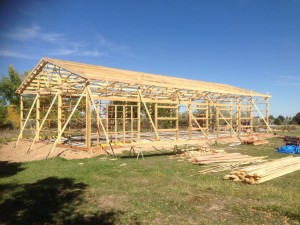I’ll never be mistaken for either Jamie Hyneman or Adam Savage of the Discovery Channel’s popular and long running series MythBusters, however I can occasionally do some debunking of urban (and rural) legends.
I do have to admit, watching MythBusters can become addicting – especially when it can be tuned in on Netflix and watched commercial free episode after episode!
Getting onto some sort of relevant topic…..
A s a popular legend has it – sawn lumber grows stronger with age, supposedly even more so as it approaches its one hundredth anniversary of being milled from a log.
s a popular legend has it – sawn lumber grows stronger with age, supposedly even more so as it approaches its one hundredth anniversary of being milled from a log.
How could this aged lumber legend have begun?
Well, it may be more than just a legend. Old wood can, in fact, be significantly stronger than on the day it was first milled.
Huh? How could this happen?
It is not like the tree is going to grow any more – it is now a board, joist, plank or timber!
Because wood does gain strength as it loses moisture content. At around 12 percent moisture content, it might be as much as 50% stronger than as rough-cut green lumber!
Read more about green lumber vs. dry lumber here: https://www.hansenpolebuildings.com/2011/09/499green-lumber-vs-dry-lumber/
Aged lumber, unlike fine wine or whiskey, generally does not get better with age. As a rule, the mechanical (strength) properties of wood show little change over time.
Typically, age works against lumber the same way it works against our bodies – I know I am realistically not near as spry at 57 as I was in my 20’s!
Other than a reduction in moisture content, everything else works to weaken wood. Over decades there is more than a passing chance the lumber has been exposed to evil stuff which can significantly weaken structural wood.
This would include nasty insects, fungi (not “fun guy” like me), being excessively loaded (too much weight on it) or elevated temperatures (think of roof framing on the south side of buildings).
Want to go further? Test the strength of a sample of rough-cut green lumber for strength properties today, come back in a hundred years or so and retest. I’ll watch for your results!







But, sap hardens over time. Sometimes it takes years to harden. This would account for older wood becoming more brittle. When the sap hardens, is the wood stronger, and in terms of its uses is it better to have stiff and strong but brittle versus weaker but soft and flexible?
In the prefabricated wood roof truss industry I worked with a fair amount of what is known as Western Larch (aka Tamarack), especially in very high strength grades such as 2850 msr. It was amazingly strong and yes – brittle. However lumber is rarely subjected to impact loads in use where brittleness would be a factor leading to a failure. Given my small amount of knowledge, I’d have to vote for stiff and strong.
The article said this:
Quote 1: “Old wood can, in fact, be significantly stronger than on the day it was first milled.”
Quote 2: “Because wood does gain strength as it loses moisture content. At around 12 percent moisture content, it might be as much as 50% stronger than as rough-cut green lumber!”
And then it says this: “Aged lumber, unlike fine wine or whiskey, generally does not get better with age. As a rule, the mechanical (strength) properties of wood show little change over time.”
What? You completely contradicted yourself. THIS is why I despise trying to find information on the internet. There are different statements from different people and sometimes from even the SAME person in the SAME article. Ugh!!!!!!!
The point is wood when first milled is green, as it dries it becomes stronger until it reaches a moisture equilibrium point. From there on out it loses strength – however it is still stronger than when first milled (when moisture content was at its highest).
Read more closely. Wood strength increases with MC decrease. That occurs as the wood dries from green to in service conditions, once.
MC in service remains relatively stable, with seasonal changes in temperature and humidity. Hence, little subsequent changes in mechanical properties.
Interesting information. My application is a century home with an 8″ x 8″ x 25′ wood beam supporting the house. There is one support post. I’m concerned about strength as this house is 160 yrs old. Should I add additional posts.?
Your question is one best answered by a Registered Professional Engineer who can inspect your actual situation and evaluate the adequacy of your particular home.